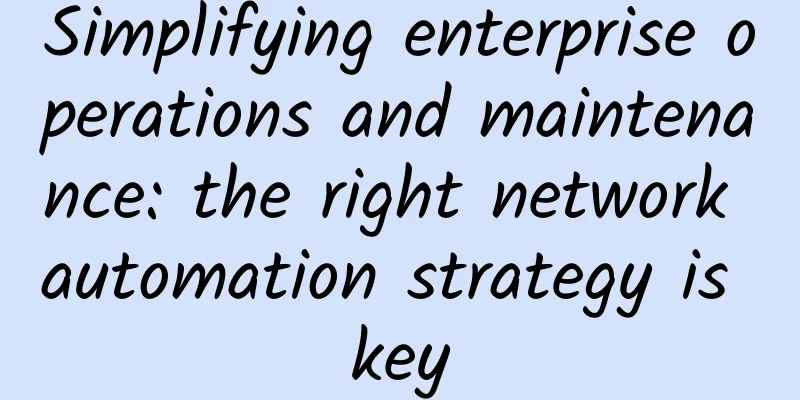Simplifying enterprise operations and maintenance: the right network automation strategy is key

|
[51CTO.com original article] From the development of mainframe computing to the client-server PC era, and then to the current distributed application environment, data centers have been constantly evolving to meet the business, mission and operational needs of enterprises. However, the network operations of data centers in many enterprises still rely on manpower, requiring operators to be well-trained and have rich professional knowledge. This dependence is not only costly, but also prone to human errors, causing network interruptions and business losses, and it is difficult to meet the high availability and agility requirements of today's networks. Network operations that rely on manual processes are high risk According to relevant data, only 16% to 30% of daily network management tasks have been automated; 80% of business experience network errors are usually caused by human errors; in non-automated networks, an average of 5 to 6 errors occur each month. If enterprises still rely mainly on manually operated networks, there may be risks such as staffing difficulties, unexpected network outages, and poor user experience. First, because manual configuration and provisioning of network services are cumbersome, enterprises find it difficult to attract, train, and retain CLI center resources with vendor-specific knowledge, resulting in higher internal costs and higher vendor support costs; second, even if enterprises can find inexpensive human resources, it is difficult to consistently and error-free apply and implement the simplest CLI tasks; third, even if the configuration is documented, manually completed configurations are prone to errors, which will slow down the deployment and provisioning of new or improved network services, thus affecting user experience; fourth, because inconsistencies and changes in network configurations are not checked in a manual environment, they are superimposed throughout the network, which in turn affects the enterprise network from unexpected outages; finally, enterprises cannot respond quickly and flexibly with new support services, which affects their competitiveness in the market. Network automation is the key to solving these problems Industry experts agree that the key to addressing these risk challenges lies in automation. The advantage of network automation is that it helps IT operations respond and change faster through analysis, and allows enterprises to try new applications and fix problems in existing applications, making enterprises more competitive in the market. By implementing automation, enterprises can improve network agility and reliability, freeing up employees to complete more strategic work, while controlling operating expenses and capital expenditures, reducing downtime and improving business resilience. However, we can see that many companies are not having a smooth journey on the road to automated operation and maintenance, such as lack of reference cases, network operation and maintenance personnel's unfamiliarity with script programming techniques, and lack of effective life management of automated programs. How to achieve network automation? Network automation requires reliable planning capabilities and the application of industry best practices to ensure smooth progress of the project while minimizing risks. As a leader in the field of automation, Juniper Networks has proposed a holistic approach to network automation and orchestration, and has developed a strategy to provide network experts with a variety of tools and technologies to reduce their operational burden in managing the network. This strategy first simplifies the architecture to make it easy to manage, reduce the number of managed devices, and abstract the complexity of the network topology. In addition, with the inherent flexibility of the Juniper Networks Junos operating system, integration with various external tools is achieved to improve operational efficiency, minimize downtime caused by configuration errors, and reduce operational expenses. According to the reporter, Juniper Networks has been advocating the development and management of network automation since it integrated XML API into the JUNOS operating system in 2001. After more than ten years of technical accumulation, Juniper Networks has combined more abundant automation implementation tools with the JUNOS operating system, providing operation and maintenance personnel with a variety of automated operation and maintenance methods. A comprehensive approach to network automation and orchestration Juniper Networks' network automation and orchestration approach consists of five main steps: simplifying architecture, simplifying operations, automation, analysis, and orchestration. ◆Simplified architecture: Juniper Networks provides a unique architectural approach that simplifies and flattens data center networks. First, achieve location independence to facilitate network planning and design. In today's virtualized data centers, applications are no longer bound to specific servers whose physical locations and associated network configurations are known. Network performance requires location independence so that resources can be flexibly allocated to any virtual machine (VM) used by the application. Second, optimize the system for east-west traffic and reduce latency between applications. Finally, the key to achieving simplicity and efficiency is to minimize the number of managed devices, thereby simplifying management. Juniper Networks Simplified Architecture ◆Simplify operations: After simplifying the physical topology, you can easily simplify operations by introducing the features needed to automate the various tasks involved in running a data center network. For example, a three-pronged approach to network automation can be used to create a more flexible and responsive data center infrastructure through provisioning, management, and orchestration. Juniper Networks' switching platforms support many built-in features, such as zero-touch deployment (ZTP); they also support a variety of open interfaces to allow integration with third-party tools. In addition, Juniper Networks also uses Junos Space Network Director to provide a single virtual management solution that can manage both physical and virtual network environments when integrated with VMware's management tools. ◆Automation: Network Director automates the provisioning of the network, manages the DHCP and TFTP servers used to store configurations and images, and enables switches to automatically download the correct version of the image and configuration. At the same time, large-scale provisioning uses configuration files based on pre-validated configurations to achieve faster service deployment and activation while preventing configuration errors. ◆Analysis: Use VM Analyzer to provide real-time physical and virtual topology views, track activities including virtual machine creation, deletion, and movement, and maintain a complete virtual network inventory; use Matrix Analyzer to monitor and analyze the operating status of the entire network structure to improve service availability; use Performance Analyzer to monitor VMs, users, ports and RF environments, as well as queue depths of devices and networks in real time; use Junos OS's cloud analysis engine to perform coordinated, end-to-end data collection, analysis, correlation, and virtualization operations to display an application-centric network view. ◆ Orchestration: Use the Network Director API to provide a single interface for all orchestration tools for end-to-end configuration and management of network services. At the same time, Juniper Networks also provides integration with third-party IT automation tools (such as Puppet and Chef) and open source tools (such as OpenStack), helping enterprises to orchestrate data center infrastructure more flexibly while saving operating expenses. During the 2017 Juniper Networks Innovation Forum held recently, Juniper Networks Global CEO Rami Rahim said: "The economic benefits brought by automation are huge, and the trend of replacing manual labor is inevitable. Automation can help humans save time and use more time for self-innovation. As a leader in the field of automation, Juniper Networks uses programmability to promote the development of the industry. In the future, Juniper Networks will also use various modern technologies including machine learning and big data analysis to build a more effective network, an adaptive network, a resilient network, and a predictive network." Today, more and more companies have embarked on the road of automation transformation, and they will inevitably encounter many difficulties. Appropriate automation strategies and trustworthy partners will be the key to success or failure. [51CTO original article, please indicate the original author and source as 51CTO.com when reprinting on partner sites] |
<<: Without big data and artificial intelligence, you may not be able to eat if you are hungry
Recommend
Using edge computing to transform networks in a 5G world
As global networks continue to evolve and become ...
Only 91 base stations were built in two years. Why is 5G millimeter wave so difficult?
[[405114]] This article is reprinted from the WeC...
TOTHOST: $1.92/month-1GB/8GB SSD/100M unlimited monthly traffic/Vietnam VPS
TOTHOST is a Vietnamese VPS hosting company estab...
RepriseHosting: $27.97/month-L5640, 16G memory, 1TB HDD/240G SSD, 1Gbps bandwidth
RepriseHosting has been providing cheap independe...
Bonree ONE 2.0: Fully launching the full-link observability journey
Recently, IDC released the "China IT Unified...
HostKvm 20% off, Singapore VPS monthly payment starts from $5.6, 2G memory/40G hard disk/50M bandwidth
HostKvm has launched a regular promotion this mon...
Payment platform: detailed explanation from gateway layer to data analysis layer
1. Payment architecture process 1. Gateway layer ...
5G is coming: analyzing the fronthaul solution of high-density wireless systems
The LTE era of wireless communications has been f...
TMThosting: Seattle high-security VPS monthly payment 30% off, optional HDD/SSD/NVMe disk, support Alipay
TMThosting is a foreign hosting company founded i...
Home Broadband IPv6 Address Allocation Revealed
Part 01 Background In 2021, the Ministry of Indus...
PIGYun: Los Angeles, USA/Korea VPS 60% off in July, monthly payment starts from 14.4 yuan
PIGYun is a Chinese merchant founded in 2019, pro...
Beware of online scams and cyber attacks during the World Cup! F5 ensures application security, allowing fans to watch the game with peace of mind
It is well known that the holiday shopping period...
SD-WAN brings new security challenges
Security is one of the top concerns for organizat...
Challenging the NB-IoT and LoRa market? A new round of competition in the LPWAN field
In recent years, the IoT industry has reached a c...
BandwagonHost: Los Angeles CN2 VPS annual payment starts at $46.7, 2.5-10Gbps bandwidth CN2 GIA line quarterly payment starts at $46.7
BandwagonHost VPS belongs to the old IT7 company....









